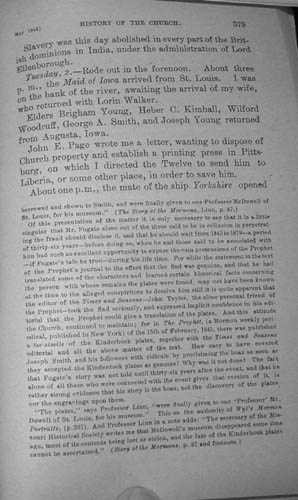Kinderhook plates: Image 8 of 8
![[First]](bw_first.gif)
|
![[Prev]](bw_prev.gif)
|
![[Index]](bw_index.gif)
|
 |
Joseph Smith, History of the Church, Vol. 5, Ch. 9, p.379 Tuesday, 2.—Rode out in the forenoon. About three p. m., the Maid of Iowa arrived from St. Louis. I was on the bank of the river, awaiting the arrival of my wife, who returned with Lorin Walker. Elders Brigham Young, Heber C. Kimball, Wilford Woodruff, George A. Smith, and Joseph Young returned from Augusta, Iowa. John E. Page wrote me a letter, wanting to dispose of Church property and establish a printing press in Pittsburg, on which I directed the Twelve to send him to Liberia, or some other place, in order to save him. About one p.m., the mate of the ship Yorkshire opened [footnote contd from page 378] borrowed and shown to Smith, and were finally given to one Professor McDowell of St. Louis, for his museum." (The Story of the Mormons, Linn, p. 87.) Of this presentation of the matter it is only necessary to say that it is a little singular that Mr. Fugate alone out of the three said to be in collusion in perpetrating the fraud should disclose it, and that he should wait from 1843 to 1879—a period of thirty-six years—before doing so, when he and those said to be associated with him had such an excellent opportunity to expose the vain pretensions of the Prophet —if Fugate's tale be true—during his life time. For while the statement in the text of the Prophet's journal to the effect that the find was genuine, and that he had translated some of the characters and learned certain historical facts concerning the person with whose remains the plates were found, may not have been known at the time to the alleged conspirators to deceive him still it is quite apparent that the editor of the Times and Seasons—John Taylor, the close personal friend of the Prophet—took the find seriously, and expressed implicit confidence in his editorial that the Prophet could give a translation of the plates. And this attitude the Church, continued to maintain; for in The Prophet, (a Mormon weekly periodical, published in New York) of the 15th of February, 1845, there was published a fac-simile of the Kinderhook plates, together with the Times and Seasons editorial and all the above matter of the text. How easy to have covered Joseph Smith and his followers with ridicule by proclaiming the hoax as soon as they accepted the Kinderdook plates as genuine! Why was it not done? The fact that Fugate's story was not told until thirty-six years after the event, and that he alone of all those who were connected with the event gives that version of it, is rather strong evidence that his story is the hoax, not the discovery of the plates, nor the engravings upon them. "The plates," says Professor Linn, "were finally given to one 'Professor' McDowell of St. Louis, for his museum." This on the authority of Wyl's Mormon Portraits, (p.207). And Professor Linn in a note adds: "The secretary of the Missouri Historical Society writes me that McDowell's museum disappeared some time ago, most of its contents being lost or stolen, and the fate of the Kinderhook plates cannot be ascertained." (Story of the Mormons, p. 87 and footnote.) |